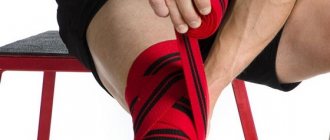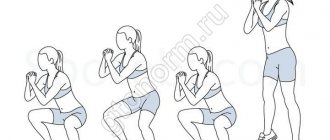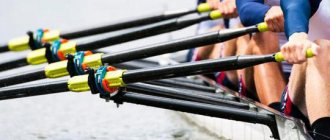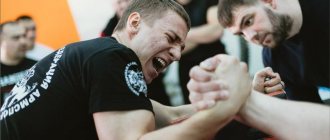Thanks to a strong grip, you can protect yourself from various injuries, get beautiful forearm muscles and get a powerful handshake. Such training is necessary for people involved in mountaineering, arm wrestling, basketball, kiting, bodybuilding and weightlifting.
There is a common belief that grip strength is entirely dependent on the size of the forearms. This statement is only partly true, and a number of specific training methods are used to develop grip, which will be discussed in detail below.
How does grip strength increase?
The biceps are practically not involved in the grip. Its strength increases as a result of active training of the forearms and hands.
Many professionals claim that they were able to develop a strong grip by doing pull-ups on a thick horizontal bar and using a bar with an increased diameter.
To increase your grip strength you must adhere to:
- The principle of progressive loads, which involves a gradual increase in working weights with each workout. To increase strength parameters and muscle growth, it is important to increase the number of repetitions and approaches.
- The principle of periodization allows you to avoid overtraining, which entails a stop in development. Therefore, it is recommended to perform exercises to increase grip strength no more than once every 7-10 days.
- According to the principle of super compensation, training too infrequently has the same negative impact on increasing grip strength as training too often. In case of loss of super compensation, the strength parameters of the hand return to pre-training indicators.
To increase such strength, it is important for the body to maintain a balance of serotonin, dopamine and testosterone. Excessive amounts of cortisol (a female hormone) greatly inhibit muscle growth. Overeating significantly reduces the production of growth hormone, so you should be very careful about the task of creating your own diet.
How to train a strong and firm grip
A strong, secure grip is an invaluable quality for many athletes, such as basketball, hockey and baseball players, mountain climbers, wrestlers, bodybuilders and athletes. In addition, an iron grip means a beautiful, sculpted body and healthy muscle strength.
Many people believe that a strong grip is an advantage for those men who have naturally wide forearms. This is not entirely fair, and you can develop grip strength by practicing on your own.
How to increase your grip strength: three main rules
First of all, you should remember that the grip does not depend on the volume and power of the biceps. A strong grip is the forearms and hands, but the biceps are not involved at all.
- You should exercise regularly and not too often: grip training should occur once a week; with more frequent approaches, development will soon stop. If you are used to exercising more often, then on other days it is better to train on other muscle groups and other tasks.
- To strengthen your own grip, you need to train, constantly and gradually increasing the load. Increasing weights should occur in small doses, but with each new workout.
- And once again about regularity. If you train your grip rarely and occasionally, there will be no results. It makes sense to exercise only if you are willing to do it for a long time and regularly, without skipping.
These three rules will help you train your grip effectively and with the fastest possible results.
How to train
To develop a strong grip, it is necessary to develop a single complex, which will include exercises for pinch strength, compressive force and also holding strength. These three components essentially make up a powerful grip.
Holding strength: It is trained gradually. An effective exercise is measured walking with weights (or dumbbells) in your hands. If you live in a private house, then the most convenient way is to take heavy dumbbells and walk around the yard until there is a “fire” in your shoulders. You should exercise no more than twice a week, and once will be enough, but subject to regularity.
To develop hand compression strength, just buy a regular wrist expander. This is a simple, compact and affordable simulator that replaces large and bulky machines. You need to exercise the expander wisely, without excessive loads and with a gradual (once every month or two) increase in load, for which you should purchase a stiffer ring.
The plucking force of the fingers is trained using special expanders or a hard rubber ring, which you try to stretch with the force of your fingers. Particular attention should be paid to the thumb, but not to overwork the hand, so as not to get injured.
These simple exercises do not require much time, and you can perform them in addition to other usual exercises in the gym or at home. With regular practice, the results will pleasantly surprise you!
Grip strength training
It is recommended to perform exercises aimed at strengthening your grip at an average pace without haste. There is no need to do long intervals. Better results can be achieved by combining exercises to develop pinch strength, holding strength and compressive ability into a single complex. Before you begin performing such exercises, you need to properly stretch the tendons, ligaments and muscles of the forearm. It is best to forget about wrist belts forever, and in the gym you should pay more attention to free weights than to block exercise machines.
Powerful compressive ability
A striking example of a strong squeezing ability is the handshake, which is called the “iron” handshake. The simplest and most accessible way to develop this strength are hand expanders and special rings made of rubber. First, it is best to take an expander or ring that allows you to perform no more than 7-10 compressions in one approach. You should switch to a harder expander after 3-4 weeks of regular exercise.
Compressive force also includes chopping wood with an axe. The constant change in the position of the center of gravity, the presence of acceleration and the moment of impact contact with a strong tree give the muscles of the forearm and hand a significant load.
There is another noteworthy way to develop compressive ability, which is to lift weights using ordinary forceps. John Brookfield describes it in one of his books, and it looks something like this:
- A durable metal bucket is filled with a weighting agent at the athlete's discretion (wet sand, nails, stones or any other filler).
- The handle of the bucket is wrapped with a rope or strap. Otherwise, the weight may slip out of the tongs and cause injury.
- It is necessary to lift the bucket using tongs so that they are in a vertical position.
Everyone should calculate the weight of the weighting material, the number of approaches and repetitions for themselves experimentally. The main thing is not to overdo it with weight at the initial stage of training, however, training with too light an apparatus will also not bring positive results. This exercise is more suitable for athletes living in their own homes rather than in apartments. City dwellers can be advised to use the following alternative: taking an ordinary broom by the very tip of its handle, you need to lift it from the floor with one hand. When the exercise seems too easy, you should add a weighting agent in the form of a brick to the opposite end of the tool.
Principles of Grip Training
Grip training is the only way to strengthen your hand muscles. Without this, it is impossible to achieve extraordinary results. However, a person’s genetic predisposition also plays some role.
An athlete’s muscle mass does not always indicate the strength of his grip. It happens that the outcome of a competition is decided by the thickness of the forearm tendons, and not at all by the volume of the muscles. Moreover, the girth of the biceps does not in any way affect the grip strength of the hand - the shoulder flexor is not involved in this movement.
So, the forearm has 19 different muscles. Only 4 of these 19 provide turns. The rest are responsible for flexion and extension.
https://www.youtube.com/watch?v=B8C3CxRQxnQ
There are a number of exercises that are good only at the initial stage of training. When performed over a long period of time, they are able to maintain the current level of muscle development, but they will not be enough for further progress. We're talking specifically about grip strength.
Hanging on the horizontal bar
Constantly hanging on the horizontal bar strengthens your grip at the initial stage of training. When you can hang for about a minute with your hands on the bar, your progress will stop. Then you can increase the hanging time, but the strength will not increase. Each person’s adaptation time is different; some will stop progressing after just 30 seconds of hanging.
Of course, such a hang in itself is very useful. In particular, the longer you hang, the more your spine will stretch (this is more often a good thing than a bad thing), and the endurance of your wrist muscles will increase noticeably. Strength is not, progress will stop over time.
One type manual expander
Very often, the lack of results from training with a manual expander is due to the unchanging load on the muscles. There is training, but there is no progression - that is, you simply maintain a certain level of strength, but do not grow further. Quite a lot of people face this.
If you carry a donut in your pocket and squeeze it all the time, up to a certain point your strength will increase, and then progress will stop, because the resistance of the machine is constant.
Muscles require adaptive training: that is, as soon as the muscle has the opportunity to do a little more, this opportunity must be immediately used, forcing the muscles to make more significant efforts.
The exact same statement can be made for almost any exercise. The main thing is not to use one weight.
Holding force
The holding force has the closest relationship with powerful compressive ability, so they must be developed synchronously. To train holding power, it is recommended to use thick dumbbell handles and a bar, which will complicate the work, but will allow you to work your forearms much more effectively and strengthen your hands. One of the most effective exercises for developing holding strength is the Farmer's Walk. It is performed in a very simple way: taking heavy dumbbells in your hands, you just need to walk around with them. It is necessary to walk until a slight burning sensation appears in the forearms.
It is preferable to do the exercise at intervals of 5-6 days.
Another interesting idea is hanging on a horizontal bar, during which the weight is held using four fingers (the thumb does not take part in this exercise). Some athletes wrap a towel around the barbell or dumbbell to develop holding strength. Such tactics have a certain effectiveness, but are traumatic. Today, there are special attachments on the neck designed to expand its diameter.
Pinch force
Even in the case of developing powerful compressive and holding power, it is necessary to develop the fingers, especially the thumb, which is practically not used during standard exercises. You can load it well by holding the smooth discs away from the bar. It is best to start with pancakes weighing 5-10 kg. To improve pinch strength, you should also pay attention to the following effective exercises:
- All fingers are threaded through a piece of thick elastic, after which you need to try to straighten them completely.
Having reached the point of maximum tension, you need to hold on to it for as long as possible, without letting your fingers close. I advise you to do this exercise every day. The result will not keep you waiting long. - A rigid expander with metal or wooden handles must be fully squeezed and held in this position for 20-30 seconds using the efforts of the fingers. Performed in 3-4 sets with a single repetition.
- A Yawara, Kubotan, or a regular wooden stick is great for everyday warm-up. For example: resting one end of the projectile on your thumb, you need to alternately and with maximum effort press the pads of your other fingers on the opposite end, holding the static tension for 8-10 seconds. Instead of a stick, you can use a ball made of thick rubber.
How to strengthen your pinch grip
In another post we described an exercise with barbell plates. If you don’t have them on hand or you prefer to study at home, you can easily find a flat and heavy object in your apartment. A substitute can be dumbbells with a rope attached to them.
For thumb training. Place 4 fingers of your palm on a solid base, such as a table or chair. With your thumb out like a natural hook, place a weight on it and hold the weight in that position.
To train the remaining fingers. Stand up straight and, taking a weight in your palm, hold it with your arms down
Start with a weight you can hold for 15 seconds and work your way up. Gradually move to heavier weights. A good practice would be to do exercises on the bar, including simple hangs. Don't forget about pull-ups: they are excellent for “pumping up” the pinch grip.
Cover: Pixabay
Brush strength
Sports tricks such as tearing a book or a deck of cards into two parts, as well as straightening nails, tire irons and horseshoes are based on the strength of the hand. An effective exercise for developing this strength is the wrist curl, only the weight used is not dumbbells or a bar, but a disc. There is an option to perform this exercise with a similar grip, only in a standing position. Throughout the entire approach, the hands should remain motionless.
To increase the strength of your hands, exercises that involve holding a rope and winding a cable with weights around a handle are good.
Rotation training
The bulk of Powerball projectiles on the market are made of plastic, but there are metal models designed for advanced athletes.
Powerball is a wrist trainer that works on the gyroscopic principle. That is, the more you spin it, the greater the load will fall on the hand and forearm muscles. There are “balls” with backlight, a spin counter, a speedometer showing the current speed and other useful functions. This projectile allows you to strengthen your fingers, hands and forearms. Another very effective method of such training is dumbbell rotation. To perform the exercise, take a heavy dumbbell in each hand, after which, from a standing position, rotate your wrists back and forth counterclockwise and in the opposite direction.
Benefits of a strong grip
A strong grip is an indicator of good health, and it is not for nothing that during a medical examination in hospitals they still use a dynamometer to this day, which must be pressed with the help of hand strength. It is precisely because of an insufficiently strong grip that many bodybuilders with developed muscles turn out to be weaker than lightweight powerlifters.
The hands have a close connection with the brain, and their development has a beneficial effect on the functioning of neural networks. Its importance in such sports and disciplines as boxing, hockey, tennis, powerlifting, martial arts, workout and crossfit cannot be underestimated.
A strong grip is important not only for full-fledged work in the gym, but also for solving various everyday problems.
Grip and big sport
A strong grip is the main characteristic of athletes performing in this form of weightlifting, such as armlifting. This is a professional sport that brings athletes worldwide fame, good prizes and, of course, a sense of pride in the results obtained. In general, there is something to think about - maybe you will be able to achieve great heights in this sport.
Armlifting is not as popular as football or tennis, but an army of thousands of fans still exists.
Super grip is useful not only in itself. Developed hand muscles are of great importance in arm wrestling, powerlifting, bodybuilding, workout, tennis, and hockey. In any sport where you need to hold significant weight with your hands, grip is of great importance.










